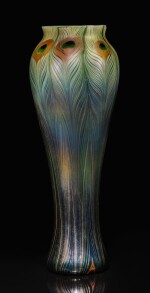Dreaming in Glass: Masterworks by Tiffany Studios
Dreaming in Glass: Masterworks by Tiffany Studios

Property from the Collection of Lloyd and Barbara Macklowe
TIFFANY STUDIOS | MONUMENTAL “AVENTURINE PEACOCK” VASE
Auction Closed
December 12, 11:00 PM GMT
Estimate
30,000 - 50,000 USD
Lot Details
Description
Property from the Collection of Lloyd and Barbara Macklowe
TIFFANY STUDIOS
MONUMENTAL “AVENTURINE PEACOCK” VASE
circa 1926
favrile glass
engraved Exposition Special/6359N Louis C. Tiffany-Favrile with an old paper label numbered 79
21⅞ in. (55.6 cm) high
Maude Feld, New York
Acquired from the above by the present owner, circa 1972
Martin Eidelberg, Tiffany Favrile Glass and the Quest for Beauty, New York, 2007, p. 48 (for a related monumental "Peacock" vase)
The peacock was one of Louis Tiffany’s favorite decorative motifs and he incorporated it into the full range of his work, from leaded glass windows to jewelry. He was obviously intrigued by the vivid iridescent blue, purple and green sheen of the bird’s feathers. Peacock-decorated Favrile vases were first displayed at the company’s Fourth Avenue showrooms in the early spring of 1897, and the timing was entirely due to marketing considerations. Tiffany was well aware that Christians believed the peacock’s shedding of its feathers each year and growing newer, more resplendent plumage represented the resurrection of Christ. Several New York City newspapers, probably given the information by Tiffany himself, reminded the public of the peacock’s symbolism and that these vases would make an ideal gift for Easter.
This particular vase is an exceptionally striking example. The reactive green body, that becomes increasingly opalescent, is decorated on the shoulder with a band of “eyes,” in two shades of green, with iridescent gold borders. The overall pulled-feather design is especially noteworthy as it was created with sparkling green aventurine glass. Tiffany discovered that by adding either copper or brass filings as a colloidal ingredient to the formula, the resulting glass would have a glittering appearance. It was this effect that caused one contemporary critic to describe aventurine as “ornamentation at once consistent, lovely, and full of mystery.”
PAUL DOROS
